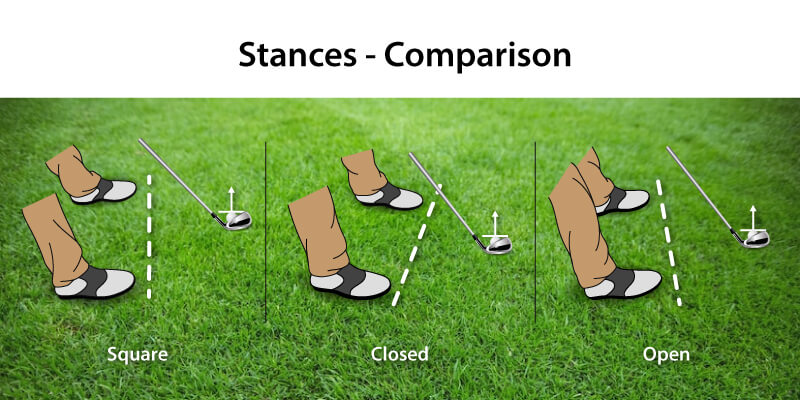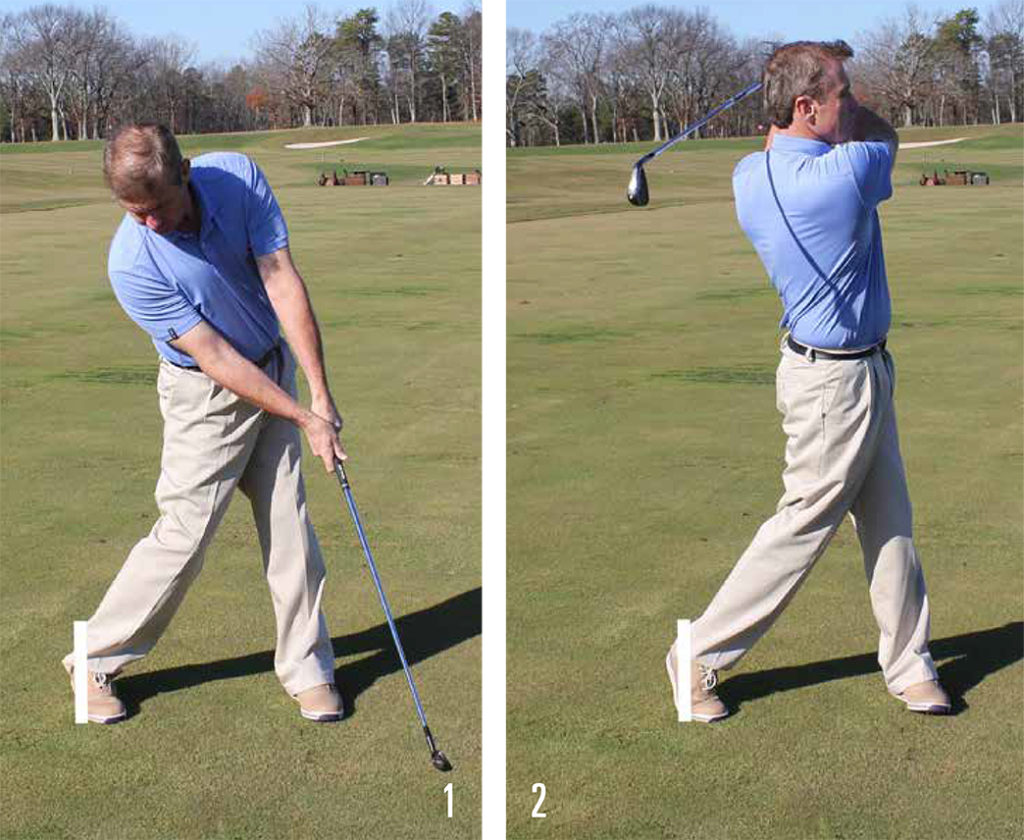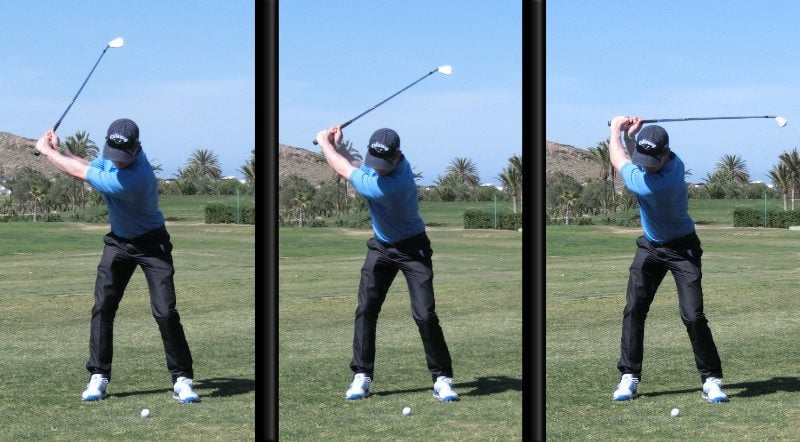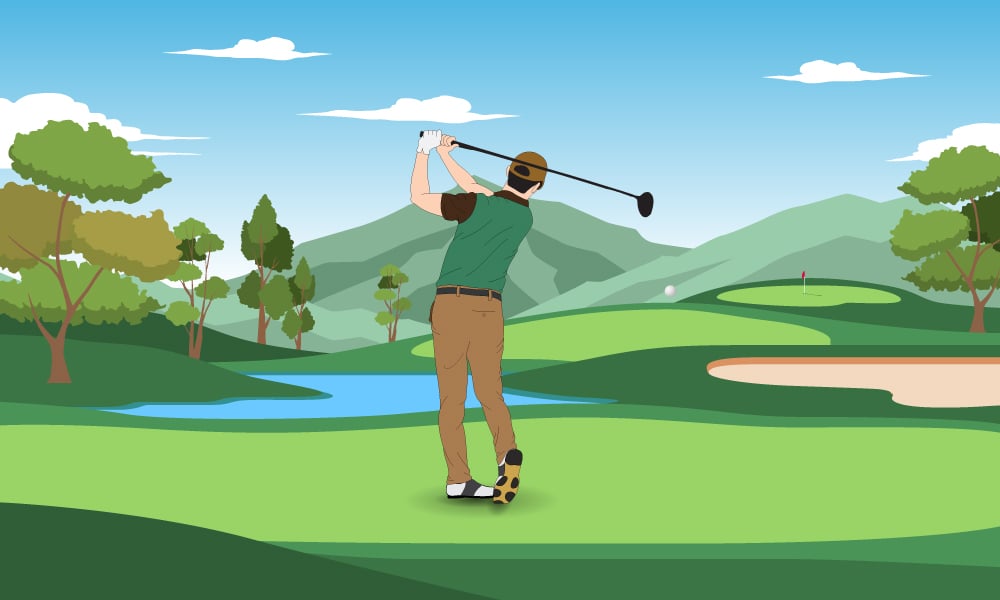A perfect golf swing is a symbol of skilled golfers. But, unfortunately, not every golfer can adapt to it quickly.
The better swing you have, the better capabilities you hold. Though there are no hard and fast rules about the golf swing, beginner golfers tend to copy the swing style from their idols. However, it can help you develop a primary swing mechanism but won’t work long.
If you are looking for an effective guide and very necessary tips to perfect your golf swing, this is the article that you must read. Here we are going to share the basic to advanced information about the golf swing. No matter if you are a beginner or pro, this guide will still help you. By the end of this article, you will have every detail of a golf swing and develop the best one for you.
First of all, let’s start with the basics. Here are the key factors that you need to consider to develop your golf swing.
Table of Content
Golf Swing Basics
A few factors like stance, grip, footwork, backswing and follow-through play a crucial role in a perfect golf swing. You can develop a good swing when you know these factors and execute them well. Each of these factors is related to each other. Let’s have a clear picture.
Stance

Your stance is one of those determiners of a perfect golf swing. It is the first thing you need to develop your golf swing. It refers to the way you stand before a golf ball, prepare your club to face the ball, and swing your golf club at it. Your stance can be open, closed, or square. The image illustrates all three types of stances you can have for a golf swing. Place your feet as shown in the image and practice some shots. You will find the difference yourself.
Grip

Having a proper grip is as important as hitting the ball properly. If you hold the club loose, your club may slip out of your hand. Also, if you hold it too hard, you will not generate enough power for your shot. So a balance in between is what you need to find out.
Footwork

Proper footwork in golf is the signature of a professional golfer. You can get an excellent idea of a golfers’ skill set by looking at their footwork in a golf swing while playing several shots. Footwork helps you master and balance your backswing and forward swing by developing the most efficient power sources.
How to develop golf footwork? We have a detailed guide on it as well.
Backswing

The golf club’s movement from just after takeaway to the top of the swing is called golf backswing. The purpose of a golf backswing is to create clubhead speed for impact. To do that, the club needs a certain distance from the golf ball to gain some energy. And this energy creates clubhead speed for impact.
How to Swing a Golf Club
(Step by Step Guide to Perfect Golf Swing)
Although in golf, there is nothing like a perfect golf swing. It’s just something that might work for you; for others, it might not. The training aids used in this tutorial will not make you perfect but can shorten the learning curve and make it easier. Here are the four steps for perfecting your golf swing.
Step 1: Develop your stance correctly
Here is a simple guideline to help you develop a proper stance for the golf swing.
- Keep your legs and shoulder-width apart at the beginning. Then adjust a little based on the clubs’ length you are using. Don’t bend your knees but be comfortable with your stance.
- Do some shadow practicing and check your balance by keeping your attention on your toes and feet.
- Maintain a posture that you are comfortable with.
Step 2: Use the best gripping technique
There are three types of grip used by pro golfers. They are interlock, overlap, and baseball. You can choose any of them, but you will have the added advantage of adjusting your grip based on the swing requirement if you know all these types and execute them. There are 3 techniques to find out your natural grip.
- Place your hands on the golf club and put the clubface vertically in front of you. Now you should be able to rotate the clubface equally in both the right and left directions. Or you can say rotate the club closed and open roughly the same amount.
- If the V’s of your lead hand run straight towards you and the trail hand is slight to the right, then it should be okay.
- Another great way to see if you have a natural grip is to hold the club horizontally and observe the back of your hand.
We have a detailed article to guide you on how to hold a golf club – the correct grips. You can take help from there to learn more about it. Every time you play your shot, your grip plays a role in it.
Step 3. Adapt to a perfect backswing
To make an ideal golf backswing, you ought to have the right golf swing action item and turn your hips after the focus point. Then, at that point, you should keep your left heel on the ground while moving your arms. Whether or not you should twist your two knees is additionally essential to know for a legitimate golf backswing. So, the highlight of developing a backswing is:
1. Correct the golf swing takeaway
2. Rotate your hips after takeaway
3. Keep your left arm straight and left heel on the ground
4. Keep your knees bent
Learn more from our Backswing Guide.
Step 4: Follow the ball and complete the swing
You should feel it while downswing. It should feel like you are hauling or somewhat pulling the top of the club, so it stays behind all the other things when swinging down.
- Allow your arm/shaft point to expand up to 90-degree lower,
- then, at that point, loosen up quickly through the effect region.
This makes enormous clubhead speed while permitting the body to move somewhat leisurely and keep up with control. It isn’t basic how far back you take the club, yet assuming that you discharge the club effectively, you ought to finish.
Your belt clasp will confront the objective, the club will have swung through to a position relatively behind you, and you will be adjusted on your lead foot with the back foot adjusted on its toe. You ought to have the option to easily hold this completion as you watch the ball take off into the distance.
Types of the Golf Swing
There are no hard and fast rules of the golf swing. But based on the most popular methods of swinging, the golf club experts classify the major swing types into some categories. They are an Inside-out golf swing and square-to-square golf swing.
Inside-out golf swing
An inside-out golf swing occurs when your golf club moves from the inside of your target line, impact the inside portion of the ball, and moves away to the outside of your target line. For a right-handed golfer, it’s like swinging out to the right after impact instead of bringing your swing back to the left (inside) and vice versa for a left-handed golfer.
Most golfers start their career with more outside inside shots, but once they successfully play inside out shots, that develops their performance by a good margin. You can learn more about inside-out golf swing from our complete guide on it.
Swing to slice the ball (on purpose)
Most golfers slice the ball unintentionally and then struggle to control it. We will have the method to control your slice in the next section but here we will discuss how you can play the slice shot deliberately
- Aim Left – If you’re shooting for a flag, aim left of the flag. That way the ball will curve toward the flag, not past it.
- Have stance directed left – Set up so your feet are aimed left of your target.
- Keep your clubface aiming at the flag or target. And make a normal swing.
In a normal swing, your right elbow stays fairly close to your side throughout your swing, and you don’t want to change that. You aimed farther left so you wouldn’t have to change your swing.
Square to square golf swing
The square to square golf swing is one of the latest and famous golf swings. The term square to square is self-explanatory. The basics of this method are to close or square the clubface from backswing to downswing and follow through.
Many golfers can square the clubface halfway in the backswing and halfway in the follow-through. The term “square to square golf swing” was initially claimed back in the ’70s and was presented by Jim Flick. Initially, the results were disastrous, and Flick later apologized for promoting the swing.
Practicing is the best option to master this swing technique. You can read our guide to know more about this golf swing. The trick of this swing is to have a parallel shoulder to the target line. This could be the reason you may face difficulties adapting to this at your earlier stages. Several drills and exercises can help you adapt to the swing technique.
Swing to hit a fade
A fade is a golf shot that features controlled movements of a golfer’s ball, and it shifts from the player’s left to his right during its flight (for a right-handed golfer). By following these five steps, you can get the whole thing clearly about hitting a fade. The steps are given below.
- Weaken your grip.
- Keep your goal slightly to the left.
- Hit with a slightly open face.
- Ignore overswing. Overwhelming swinging with an open swing promotes a slice.
- Tee the ball downward and link the core of the ball with the soft spot of your driver. A shorter length on the teed-up ball will allow you to swing more. Keep in mind that you shouldn’t kill the ball. A fair swing will make the fades easier.
Click the section headers for a more detailed guide; our comprehensive guide to this training is attached there.
Advanced Tips to Take Your Golf Swing to The Next Level
Having the perfect swing is not as easy as most people may think. It takes time and practice to perfect it. In that process, many golfers make some common mistakes. Now, you have a good idea of how to have a good swing. But you will require some advanced practice drills to make your swing a great one. Follow these tips to enrich your swing.
Increase your golf swing speed
Updated golf clubs can help you add more distance with their functionality. You can even hit further with your muscle power. But the best method is to increase swing speed. To increase your golf swing speed, you need to work on the following concepts:
- Turn legs during the follow-through
- Turn knees along with your legs
- Turn hips to generate power
- Turn torso to keep balance
- Turn shoulder and bring momentum to the club
- Transfer body weight into shot power
- Have a full swing
While doing so, keep an eye on the following do’s and don’ts to avoid injuries and better your performance.
Do’s: Things to do to improve your golf swing
- Practice with heavier clubs
- Have a low grip pressure
- Turn the body while standing firm on the ground
- Shoulders should be parallel to the target line
- Have an extended swing follow-through after hitting the ball
Don’ts: Things to avoid to improve your golf swing
- Do not bend too much
- Do not hold the club too firmly
- Do not try to overpower your strength
- Do not stop swinging your arms after hitting the ball.
Control your slice shot
A few simple steps to straighten golf shots from slicing them are the following. Once you know precisely what is wrong with your current stroke play, you can jump onto that specific point and rectify it. If you don’t know the specific factor bothering you, go through the steps in the same order described.
- Aim straight
- Putting your golf ball in the proper position
- Take the right club
- Reconstruct your grip
- Swing properly
- Transfer your weight & release the club before impact
Follow our detailed guide to fix your slice.
Practice with a swing analyzer
The swing analyzer is part and parcel of improving golf swing and performance. It is also known as ‘golf swing tracker” and ‘golf swing speed radar.’ You can use simulators (which includes a swing analyzer) or a swing analyzer only to develop your swing and get better in Golf.
There are numerous types of golf swing analyzers available in the market. Know each type first and then decide which one will be best for you. The three types of swing analyzers are the classic swing analyzer, wearable analyzers, and launch monitors.
Get the best swing analyzer review in our dedicated article.
Conclusion
Thank you for reading our golf swing guide. Now you have a good understanding of golf swing and how to develop your swing. We have attached our other golf swing-related guides to this article as well so that you have access to enrich your knowledge when needed. Hopefully, you have all your queries answered here. But if we failed to satisfy you or missed out on any crucial information do comment below. Our team will get back to it soon.
Till then keep practicing. Because you can perfect your swing only through proper guidelines and practices.

